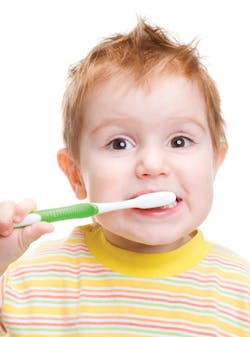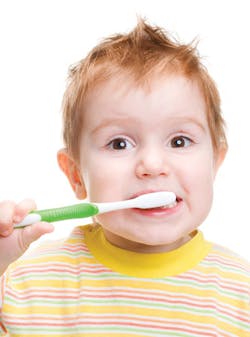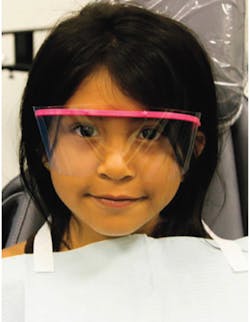Parenting and dental care: Survey analysis focuses on parental awareness and behavior
Survey analysis focuses on parental awareness and behavior
BY Timothy S. Martinez, DMD; Josih Hostetler, MSW; Jenny Tjahjono, DMD; Marc Bernardo, MPH
Methodologies
Western University of Health Sciences College of Dental Medicine (WesternU CDM) contributed to a survey focused on dental care conducted with dental patients in early 2014. The survey focused on patient attitudes, knowledge, and beliefs regarding dental care for children and dental infection control for both themselves and their children.
The topics included the age a child should first see a dentist; use of dental sealants; and the use of disposable supplies in the dental office. This survey was conducted online among 304 adults 18 to 65 years of age throughout the United States. An augment survey was also conducted among 75 respondents ages 18 to 65 who fell below the U.S. poverty threshold. These interviews were conducted by telephone using the same format as the main sample.
Dental care by age one
The American Academy of Pediatric Dentistry recommends that children be evaluated by a dental professional no later than 12 months of age (AAPD, 2012). Similarly, the American Academy of Pediatrics recommends that children receive an oral health screening from their primary care provider by six months of age (AAP, 2014). This recommendation is critical, as it aligns with the American Academy of Family Physicians' direction that describes the primary care practice as "the patient's first point of entry into the health care system and as the continuing focal point for all needed health care services" (AAFP, 2014).
Of the 102 respondents to the consumer survey who are parents of children under the age of 18, the average age for the first visit to the dentist was reported at 2.5 years old.
Of the parents of children who were aware of the recommendation of dental care by age one, most stated that they did not think the visit was necessary (67%) or that the pediatrician or doctor informed them it was not necessary (22%).
----------------------------------------------
Related articles
- Pedonomics: The new economics of pediatric dentistry
- Incorporating pediatric dentistry practice and principles into your general practice
- Patience with the kids: Pediatric pain control involves quick thinking to put kids at ease
----------------------------------------------
Of those parents who were aware of the recommendation of a child's dental visit by age one, the most frequent source of this message was the child's doctor or pediatrician (41%), followed by media (32%), the parent's own dentist (23%), and a family member or friend (5%).
The evidence of social inequalities is witnessed in the results of consumer surveys completed by low-income parents. Their child's first visit to the dentist was at an average age of 3.4 years old, more than a year older than the general population. Of this population, those aware of the recommendation to seek dental care by age one, six out of 10 parents did not think it was necessary (61%). A small percentage of this group's pediatricians reinforced this belief (17%). Furthermore, from the low socioeconomic respondents, some of the parents replied that they could not afford dental service for their child (9%), and some were not aware that the dental visit would be covered by their insurance (13%).
Of concern, fewer than half (43%) of parents within the general population are aware that dentists recommend children have their first dental exam by age one.
In addition, women are more likely to know this than men. Statistically, 74% of the females surveyed were aware of the recommendation versus 31% of the males. Likewise, 26% of the females were not aware of the recommendation versus 69% of the males.
Dental sealants
Dental sealants are thin plastic coatings applied to the grooves on the chewing surfaces of the back teeth to protect them from tooth decay. In an article coauthored by the Centers for Disease Control and Prevention (CDC) and the American Dental Association (ADA), the following comments on the use of sealants were recommended: "Evidence supports recommendations to seal sound surfaces and noncavitated lesions, to use visual assessment to detect surface cavitation, to use a toothbrush or handpiece prophylaxis to clean tooth surfaces, and to provide sealants to children even if follow-up cannot be ensured" (Gooch, 2009).
The U.S. Surgeon General's report on oral health indicates that sealants can reduce decay in schoolchildren by more than 70% (U.S. Surgeon General, 2000). In the consumer survey, 95% of parents stated that their child's dentist recommended sealants. The vast majority of these parents (88%) took this advice and had the sealants applied.
Infection control in the dental office
Recent issues of infection control in the dental setting have been reported throughout the United States. One of the most current headlines included 60 patients who may have been exposed to blood-borne viruses in an Oklahoma oral surgeon's office. This incident was described to have been the country's first known outbreak of hepatitis C among dental patients (Tulsa Health Department, 2013). In another case, 20 patients in Hawaii may have been exposed to viruses such as hepatitis because of the use of unsterilized dental instruments (Garcia, 2014).
In the patient survey conducted, approximately one-third (35%) of adults recalled hearing or reading news stories about dental offices exposing patients to infectious diseases. For half of these people (54%), it has changed their outlook on going to the dentist. For those who indicated their outlook had changed, they now report as being more attentive to the cleanliness at the dental office (41%).
Others reported being more nervous about going to the dentist (21%). Respondents did state that they would ask their dental professional more questions about how they clean the dental equipment and office (14%). Additionally, 34% of adults expressed concern about the cleanliness of the bib holders their dentist uses. Nine out of 10 respondents expect the bib clip to be clean or sterile, which was similarly reflected in the lower-income cohort (83%).
Equipment utilized in the dental office can potentially harbor pathogens if not properly disinfected. Even something as simple as the bib clip around a patient's neck can harbor pathogens. Although a bib clip is considered a noncritical instrument, it needs to be reprocessed between patients by intermediate or low-level disinfection (CDC, 2008). According to a study performed by Tufts University School of Dental Medicine and the Forsyth Institute, utilizing bib clips at a hygiene clinic, "chains that were used throughout the day without being cleaned between patients' appointments showed high concentrations of bacteria on their surfaces." This study also found that "40% of the bib clips tested post-disinfection retained one or more aerobic bacteria and that 70% of bib clips tested post-disinfection retained one or more anaerobic bacteria" (Alt-Holland, 2013). Furthermore, the ADA made a recent comment about infection control in dental settings. According to Dr. Faiella, "While isolated cases occur, it understandably raises questions about infection control in the dental office. The ADA encourages people to talk with their dentists, who will be glad to explain or demonstrate their infection control procedures" (ADA, 2013).
Of the respondents who expect a sterile bib holder, 30% said they would definitely or probably ask for a disposable bib holder on their next visit. This was more prevalent in the low-income group, because a greater proportion (72%) of this group commented that they would ask for a disposable bib clip the next time they visited the dentist. All respondents feel their dental practitioners are doing everything they can to create a clean environment and provide sterile equipment. In order to ensure quality assurance for infection control, WesternU CDM utilizes disposable bib holders in all community-based clinics.
Interprofessional collaboration
The trends in the consumer survey regarding both the communication of a child's dental visit by age one and the recommendation of an oral exam by six months by a primary care practitioner do point toward the positive influence of interprofessional collaboration on oral health. There is also a lower percentage (23%) of messaging from the dental profession regarding the establishment of a dental home by age one. At WesternU, the focus in the DMD program is a "paradigm shift in dental education" leading to general practice dentists who are prepared to see children in all practice settings by age one. This new cohort of dentists will lead the transition of the profession toward early intervention to eradicate early childhood caries.
Disposable bib holders eliminate the risk of cross-contamination.
The World Health Organization (WHO) and its partners recognize interprofessional collaboration in education and practice as an innovative strategy that will play an important role in mitigating the global health workforce crisis. Interprofessional education occurs when students from two or more professions learn about, from, and with one another to enable effective collaboration and improve health outcomes. Collaborative practice happens when multiple health workers from different professional backgrounds work together with patients, families, caregivers, and communities to deliver the highest quality of care. It allows health workers to engage any individual whose skills can help achieve local health goals (WHO, 2010). WesternU CDM works with multiple health professions, such as nurses, medical doctors, physician's assistants, and other fields, to establish an opportunity to provide high quality oral health care in the primary health setting. This unique model encourages health professionals to adopt early oral health intervention practices.
Conclusion
This consumer survey displays the dental patients' attitudes, beliefs, and knowledge of infection control in the dental office, the age of the child's first dental visit, and the use of dental sealants. Continued messaging on the importance of establishing a dentist-patient relationship by age one, by all health professions, will be critical to parents' knowledge and use of this information. Also, the communication on the importance and use of dental sealants will be crucial to the continued eradication of early childhood caries. Information regarding utilization of proper infection control technologies will continue to help educate dental consumers on what type of products are available for their use in the dental office. RDH
Author's note: The patient survey was implemented with a grant provided by DUX Dental.
Dr. Timothy Martinez currently serves as the associate dean for Community Partnerships and Access to Care in the College of Dental Medicine at Western University of Health Sciences. He graduated from the Harvard School of Dental Medicine in 1986 with a fifth year concentration in health care administration. He has had extensive experience for over 25 years working in community health center settings, treating a variety of underserved patient populations. Over the past five years, Dr. Martinez served as the Medicaid Dental Director for the Commonwealth of Massachusetts, changing regulations crucial to increase dental access for vulnerable populations.
References
1. Alt-Holland A, Murphy, CM, Powers A, Kublin CL, Jeong YN, DiMattia M, Pham L, Park A, Finkelman M, Lombard M, Hanley JB, Paster BJ, Kugel G. (2013) Comprehensive analysis of aerobic and anaerobic bacteria found on dental bib clips at a hygiene clinic. Compendium of Continuing Education in Dentistry. 2013; 34 (4).
2. American Academy of Family Physicians. (2014) Primary Care. Retrieved from: http://www.aafp.org/about/policies/all/primary-care.html#1
3. American Academy of Pediatric Dentistry. (2013) Policy on the dental home. Oral Health Policies. 35 (6). Chicago, IL.
4. American Academy of Pediatrics. (2014) Recommendations for preventive pediatric health care. Elk Grove Village, IL.
5. American Dental Association. (2013) American Dental Association statement on infection control in dental settings. News Releases. Retrieved from: http://www.ada.org/en/press-room/news-releases/2013- archive/september/american-dental-association-statement-on-infection
6. Centers for Disease Control, Department of Health and Human Services. (2008) Guideline for disinfection and sterilization in healthcare facilities, 2008. Atlanta, GA: CDC.
7. Garcia N. (2014) Veterans Affairs apologizes to dental patients for unsterilized instruments. KHON2. Retrieved from: http://khon2.com/2014/06/27/veterans-affairs-apologizes-to-dental-patients-for- unsterilized-instruments
8. Gooch BF, Griffin SO, Gray SK, Kohn WG, Rozier RG, Siegal M, Fontana M, Brunson D, Carter N, Curtis DK, Donly KJ, Haering H, Hill LF, Hinson HP, Kumar J, Lewis L, Mallatt M, Meyer DM, Miller WR, Sanzi-Schaedel SM, Simonsen R, Truman BI, Zero DT. (2009) Preventing dental caries through school-based sealant programs: Updated recommendations and reviews of evidence. Journal of the American Dental Association, 140, 1356-1365.
9. Tulsa Health Department (2013) Public Health Response - Situation Update 11. Tulsa Health Department News. Retrieved from: http://www.tulsa-health.org/news/public-health-response-situation-update-11#.VAC970B06So
10. U.S. Surgeon General, Department of Health and Human Services. (2000). Oral Health in America: A Report of the Surgeon General. (NIH Publication No. 00-4713). Washington, DC: U.S. Government Printing Office.
11. World Health Organization. (2010). Framework for action on interprofessional education and collaborative practice. Geneva, Switzerland.





